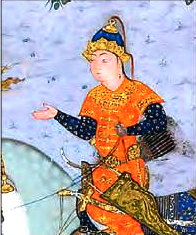User:Royal 2025
Pashang (Tur)
[edit]The origin and definition of Turan

The term Turan [1], derived from the Persian epic Shahnameh, [2]refers to eastern-Iranian borderlands and territories beyond the Oxus. [3] The territories of present-day Uzbekistan [4], Kazakhstan [5] and the northern portions of Afghanistan [6] and Pakistan [7] are all included in the Turan myth. This region is comparable to what is currently referred to as Central Asia. [8] the following areas were a part of Turan: Khwarazm; [9] Bukhara [10], Balkh [11]; and Shehersebz, [12] a city nearby Bukhara Hissar Khokand, [13] Durwaz, [14] Karategin, [15] Kunduz, [16] Kafiristan, [17] Chitral, [18] Gilgit, [19] Skardu. [20] and northern steppes (Kazakhstan).
The division of power in Ferydoon's empire
[edit]
According to the Shahnameh, the kingdom of Airan expanded during the rule of the legendary King Ferydoon [21] to become an empire that covered countries from the Indus Valley [22] in the south to present-day Turkey [23] in the west, covering an area nearly the size of the sixteen nations of the Vendidad. [24] Ferydoon decided to divide his huge kingdom among his three sons. He gave the eastern lands to his eldest son Tur- a nation that came to be known as Turan. Ferydoon gave Airan and Hind the (Indus lands) to his son Iraj, and he gave the remaining eastern kingdoms to his son, Salm.
Tur's ambition and murder of Iraj
[edit]The kingdoms of Airan and Hind were the crown jewels of the empire and the source of its power, and Tur felt insulted as the eldest son. Shortly after Ferydoon divided his realm, the ambitious and jealous Tur convinced Salm to join him in a plan to murder Iraj.
Tur's temporary domination of Airan
[edit]
In Ferdowsi's tale, Turan briefly rules over Airan after Iraj's death, with the continued conflict between the two lines of descendants. During the Persian Kai Kavoos [25] period, Afrasiab, [26] a Tur descendent, ruled the kingdom of Turan, causing multiple conflicts between Turan and the Persians for the rule of the eastern provinces (Eduljee).
References
[edit]1. “Kingdoms of Central Asia - Turan (Indo-Iranians).” The History Files, www.historyfiles.co.uk/KingListsFarEast/AsiaTuran.htm.
2. "Malandra, William W. An Introduction to Ancient Iranian Religion : Readings from the Avesta and Achaemenid Inscriptions. University of Minnesota Press, 1983."
3."Moazami, Mahnaz. Wrestling with the Demons of the Pahlavi Widewdad : Transcription, Translation, and Commentary. Brill, 2014."
4."TURAN.rootshunt.com/aryans/indiairanandaryans/listofancientiranianpeople/tu ranians/turanians.htm."
5."Uzbekistan Region. Turan / Tuirya, Sugd, Sogd, Sogdiana, Sogdania and Zoroastrianism. heritageinstitute.com/zoroastrianism/sugd/index.htm"
